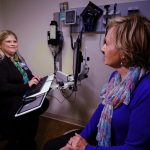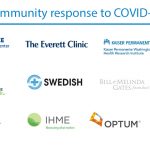The Value of Health Information Technology in a Time of Crisis
In time of sheltering in place and avoiding contagion, the use of portals, telephonic resources, virtual care is essential.
Today, almost every physician practice has a patient portal and electronic health record. Those practitioners who have assertively promoted these options and gained adoption within their patient population are in a much better position to be in touch with their patients virtually.
Also, a systems approach is required to extend those tools to engage patients and integrate them with call centers, outreach programs, mobile apps, scheduled e-visits, and more advanced telehealth platforms.
Instead of waiting for patients to call and come in, proactive systems are reaching out on social media and email to educate patients, direct them to appropriate points of care, and attempt to separate the potentially infectious patients from those seeking care for other reasons. Some systems like Intermountain Health in Utah are leading social media conversations with local public health agencies to educate and engage their community at scale
Many systems have operated nurse advice lines for decades to offer afterhours advice and minimize avoidable emergency room visits. Advice lines and call centers, able to take inbound calls and send outbound messages, are adding a dedicated line for patients suspecting they may have COVID-19. Many of these advice lines can book appointments and direct patients to the right site of care — be it urgent care, a testing site, or a scheduled virtual visit.
Multi-specialty group practices and integrated systems that had built and extended digital tools — and engaged their patients to register for e-mail alerts and go online to make appointments or refill prescriptions — are in a much better position to respond quickly and reach patients in timely and effective ways.
Likewise, health care providers with a robust telehealth/video visit system are quickly able to adapt those systems for emergency screening and communication with patients.
In recognition of the national emergency, Congress and the Trump Administration have lifted restrictions on telehealth for Medicare and Medicaid patients, and many governors are easing licensure restrictions to enable virtual care across state lines.
Council of Accountable Physician Practices Co-chair Stephen Parodi, MD, observed in mid-March of the pandemic, “I think this pandemic will bring in a fundamental change in the way we practice medicine and in the way the health care system functions in the U.S.,” he said. “We’re going to come out of this and realize a lot of health care visits don’t have to be in person.”
Examples of best practices in using health care technology
Marshfield Clinic in the upper Midwest, Geisinger Health in Northeast Pennsylvania and Advocate Aurora in Chicago are a few of the systems proactively directing patients to their 24/7 nurse advice lines, both via an internet portal and social media.
And, if the toll-free line is busy, patients can fill out self-assessment tools that can be found on portals and mobile apps or have a chatbot take them through a symptom checker, as Intermountain Health does. Responses to a few simple questions can be used by staff to direct them to the appropriate next step or steps. Minnesota’s Health Partners system has incorporated a self-assessment tool in its digital triage system. An early telehealth innovator through its Virtuwell platform, Health Partners now has a well-tested platform for triaging low-acuity patients staffed by nurse practitioners licensed in multiple states.
Virtual and e-visit technology is being offered to patients through Intermountain’s ConnectCare app. Sharp Health has a link to its PlushCare video visit platform for patients seeking COVID-19 screening and to shift in-person visits to video to minimize infection risk and enable the system to mobilize for expected surge. Ochsner Health is promoting its MyOchsner app, and using this time of heightened anxiety to offer tele-behavioral health visits.
Everett Clinic, located in the COVID-19 hotspot of greater Seattle, is scheduling video visits for non-COVID-19 patients and directing suspected cases to dedicated urgent care center locations.
As the demand for telehealth is surging in some locations and systems, the technology is sometimes straining under the volume, and the lack of clinicians to meet demand is also a concern. The trusted Cleveland Clinic is working through some early challenges with its telehealth partner, American Well, to overcome these barriers to care.
Some systems are waiving co-pays and offering low-priced or even free care via digital tools to help better triage and separate patients, giving frontline staff and leaders precious time to prepare for more severe cases. Some health systems that are offering lower cost or even free options include Essentia Health and HealthPartners in Minnesota.
Right time, right patient, right setting: managing infection risk, protecting frontline workers
Inadequate testing capacity has hindered the most prepared providers, but health systems are stepping up to provide or support testing and triage in sites and places that can manage large numbers of worried patients safely. While delays in testing are frustrating for patients and clinicians alike, integrated information technology has enabled health systems to manage the volume of testing using the initially narrow testing criteria. Some systems are also limiting the number of entry points to facilities in order to screen patients while also conserving critical personal protective equipment for frontline staff.
Drive-through testing sites are providing safe alternatives to keep patients out of waiting rooms and emergency departments. Kaiser Permanente’s MidAtlantic region set up an operation to serve members across its service areas in Maryland, Virginia, and Washington, DC. Essentia Health in Duluth, Minnesota (link) and Baylor, Scott and White in Texas have also deployed drive-through testing sites.
Northwell Health in New York has developed a Coronavirus Digital Resource Center for patients. It is also one of the few health systems at this date who have their own approved laboratory and can test for COVID-19 directly. Northwell is also supporting a drive-through testing operation in New Rochelle, New York, an early hotspot of the outbreak.
Henry Ford Health System in the greater Detroit market has set up triage tents outside the emergency department at five hospitals in preparation for patients who need to be treated separately to protect other patients and staff. Henry Ford has also developed their own in-house test and is operating drive-through testing.
Behind the scenes, using data and teams for better surveillance, preparation for severe cases
As millions of people query “Dr. Google” and social media networks, health systems are using those same data sources as early alert systems to track the geographic course of the pandemic and focus on their own preparations.
Supply chains and inventories for critical personal protective equipment and ventilators are now easier to track and move thanks to digital technologies.
In-house research teams are teaming up with clinical leaders to update protocols based on real time data from outside and within their own systems. Leading systems such as the Mayo Clinic are sharing their approach to foster learnings across systems of care.
Conclusion
Multi-specialty medical groups and health systems have an opportunity and obligation to demonstrate their leadership and commitment to their communities during the unprecedented COVID-19 pandemic. As the needs surge at different paces and trajectories across the U.S., these physician-led organizations are demonstrating the efficacy of a systems approach to health care delivery and are accelerating the development of tomorrow’s delivery system innovations. This bright spot in an otherwise frightening and challenging crisis will be explored in our next blog.





